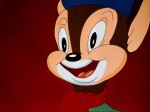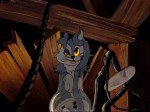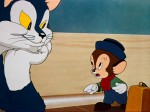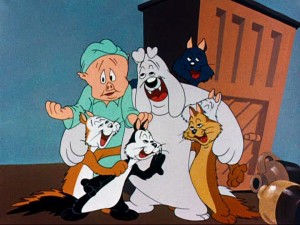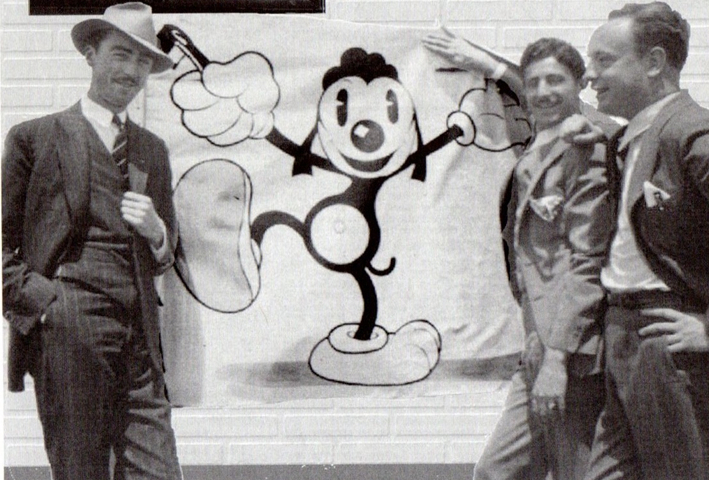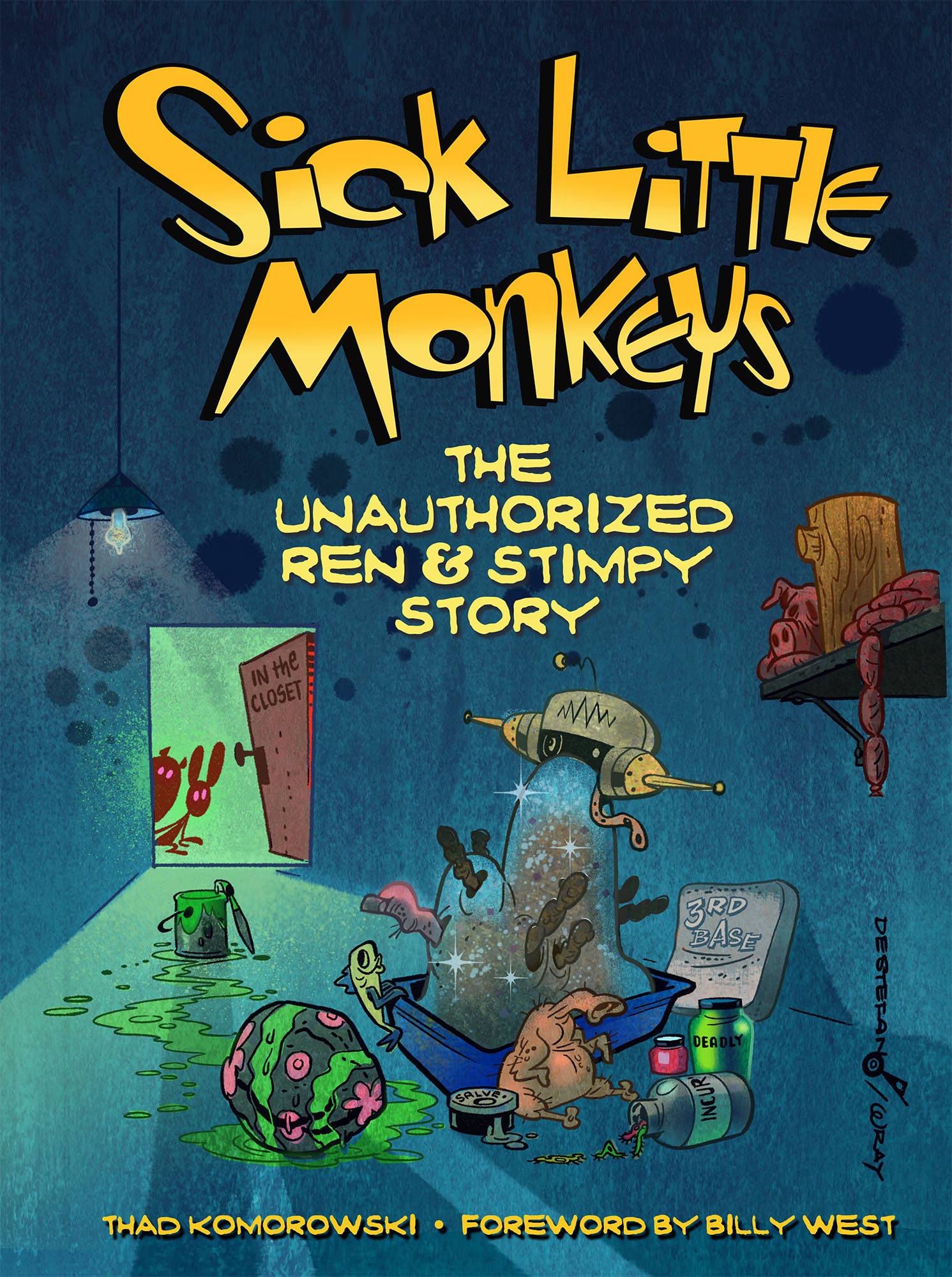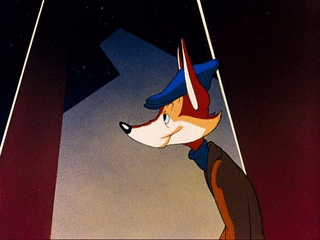
The light has just gone out in the bears’ house, and the Cockney fox takes a drag on a cigarette. It is a very intricate special effect done to give an ominous feel to the opening scene. It’s also an exceptionally staged layout. Above is a [poor] animated GIF illustrating a lighting effect I had never noticed before in The Unbearable Bear. The great restoration drew my attention to it.
I guess the overall sentiment regarding the very odd Looney Tunes Mouse Chronicles collection that was released to Blu-Ray and DVD this week is that it’s a showcase that very accurately illustrates the evolution of Chuck Jones’s directorial style over his fist twelve years. These Warner cartoons get me thinking like nothing else can, so bear with me on this one.
This will be a minority opinion, but I don’t think the early Jones cartoons (arbitrarily, before the 1942 release season) are as bad as they’re made out to be. Though it is a little torturous to watch all of these Sniffles cartoons in one sitting, isn’t that true of most reoccurring characters? The Sniffles cartoons are more charming and successful as gentler comedies than the Disney Studio films were, particularly when Disney was using characters that specifically demanded rougher edges and sharper timing (Donald Duck specifically).
The early films are often quite off, and I would only consider very few of them classics (most certainly Naughty But Mice, Little Brother Rat, and Bedtime for Sniffles). Yet isn’t the near entirety of 1939-40 Schlesinger cartoons a little off? Consider that while Jones was too cutesy, Tex Avery was knocking out travelogue after travelogue and Bob Clampett was directing many very weak Porky Pig cartoons (ones that used radio references as crutches and showed plain exhaustion with the character). Nothing of merit came from the Ben Hardaway-Cal Dalton unit. Almost cynically, things get back on track again at Schlesinger’s when Friz Freleng, the least innovative but funniest of the directors, returns.
The man did have a flair for comedy and charisma from the beginning. However clumsily handled, Jones also had a penchant for humorous self-awareness, as exemplified by the intelligently insane Daffy in Daffy Duck and the Dinosaur and Bugs Bunny in Elmer’s Candid Camera and Elmer’s Pet Rabbit. In The Brave Little Bat, the titular Batty is a deliberate assault on the viewer’s patience; he is so overly cutesy and obnoxious that there’s no other way to take him than intentionally taxing. (This is emphasized by a rather repulsive shot of the damage that befalls a cat after he falls from a ledge – more or less Batty’s doing.) He reused the gabby-to-the-pont-of-abhorrence gimmick even more brilliantly in The Unbearable Bear.
The most overwhelming flaw evident in all of these Sniffles cartoons is the bloated timing. Animators tend to mimic the kind of timing and gag structure Laurel and Hardy specialized in (whether they’re aware of it or not). In the best Laurel and Hardy films, even the most mundane of routines have a life of their own, thanks mainly to the rich, unpretentious nature ingrained in the duo’s acting. The animator merely thinks a scene can be made funnier if it’s longer, and since he or she doesn’t have a being that can think for itself at his or her disposal, so the drawing (and thereby acting) becomes too self-conscious. There is no grace to be won and the payoff usually isn’t worth the belabored set-up. It’s a problem with most Disney cartoons and their imitators; early Jones is no exception.
It’s never been explicitly stated why Jones set out to improve his timing and cutting. Supposedly Freleng went to bat for Jones when Schlesinger was planning to demote Jones because he didn’t like his earlier pictures, in spite of them getting positive audience response and even glowing reviews (Manny Farber was a shill for Jones his entire career). Freleng told Jones that he had to get more speed, and comedy, into his pictures like he, Avery, and Clampett had. Jones knew Freleng was right, and much to his resentment, he knew Schlesinger was too. It didn’t stroke his ego, that’s for sure.
Freleng said (according to Corny Cole), “Chuck Jones brought ego into the animation business.” I think that’s largely hyperbolic, because any art worth taking seriously is the product of ego (Freleng’s best work included), but it’s one of those statements grounded in truth that Freleng always blurted out with no reservation.
Chuck Jones really is ego personified in animation, and for a large part of his career, it was ego intelligently applied more successfully than anyone else has ever managed. The proof? A string of roughly fifteen years worth of cartoons that are unbelievably great, a claim no other animation director can make. (Only when Jones was clearly uncomfortable with the story material did a true dud arise, as in the heavily referential and brutish Hush My Mouse, appearing with original titles on this set.)
The second disc of this collection, collecting the entirety of the woefully short-lived Hubie and Bertie series, illustrates a prime chunk of that period. Here, writer Mike Maltese’s influence was at its strongest, and was when Jones realized how arty and funny his cartoons could be. Needless to say, he made every effort to make them as great as possible.
I can think of very few directors in commercial Hollywood who are as wholly present in their cartoons as Jones is, right down to the very frame. His ego gave him a confidence in his own drawings that Avery, Freleng, and Clampett completely lacked. All of them more or less channeled their personalities through their writers, animators, and layout men. Yet it was only Jones who actively used his team to make up for his own weaknesses, and only within the confines of his ivory tower.
It’s why Jones didn’t have much use for Bob McKimson in his unit. McKimson was inarguably the best and most important animator at the studio, but he was, to appropriate a phrase I picked up from cartoonist/writer Jim Gomez, “his own bastard”; an artist with his own ego that didn’t jibe with Jones’s. He was a technician far better off with directors who lacked faith in their own drawings (Avery) or actively wanted his input to booster their cartoons (Clampett).
Sometimes Jones’s beautiful layouts didn’t work for animation purposes, and sometimes a story needed to be more biting to work. Jones knew that his team helped make the cartoons what they were and was probably grateful for the help, even if he disparaged them later in his “my way or highway” demeanor (Jones’s statement that Ken Harris wasn’t a good “draughtsman”, the condescending portrayal of Mike Maltese in Chuck Amuck).
Ego is a curious, incurable disease that can do irreparable harm. It certainly negatively affected Jones’s output in his last forty or so years on the planet, when he went back to his over-drawn, bloated ways, only with none of the charm of Sniffles the Mouse. But as a repertoire like his filmography proves, ego can be a very wonderful thing if the conditions are right and the person in question is surrounded by the right people.
I was intending to say most of this more towards September 21st, which will mark the centennial of Jones’s birth, but this DVD release expedited it a bit. Surely his films will delight and captivate people for another hundred years, but will the medium/industry give us another Chuck Jones, an individual capable of maintaining greatness with regularity for a similarly long period? It hasn’t done so yet, and it seems rather doubtful.

